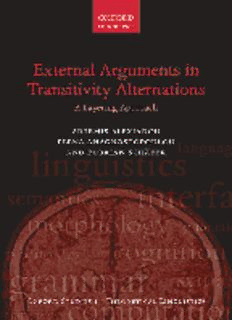
External arguments in transitivity alternations : a layering approach PDF
Preview External arguments in transitivity alternations : a layering approach
External Arguments in Transitivity Alternations OXFORD STUDIES IN THEORETICAL LINGUISTICS generaleditors DavidAdgerandHagitBorer,QueenMary,UniversityofLondon advisoryeditors StephenAnderson,YaleUniversity;DanielBüring,UniversityofVienna,LosAngeles;NomiErteschik-Shir, Ben-GurionUniversity;DonkaFarkas,UniversityofCalifornia,SantaCruz;AngelikaKratzer,Universityof Massachusetts,Amherst;AndrewNevins,UniversityCollegeLondon;ChristopherPotts,StanfordUniver- sity;BarrySchein,UniversityofSouthernCalifornia;PeterSvenonius,UniversityofTromsø;MoiraYip, UniversityCollegeLondon Recenttitles 35TheLogicofPronominalResumption byAshAsudeh 36ModalsandConditionals byAngelikaKratzer 37TheThetaSystem ArgumentStructureattheInterface editedbyMartinEveraert,MarijanaMarelj,andTalSiloni 38Sluicing Cross-LinguisticPerspectives editedbyJasonMerchantandAndrewSimpson 39Telicity,Change,andState ACross-CategorialViewofEventStructure editedbyVioletaDemonteandLouiseMcNally 40WaysofStructureBuilding editedbyMyriamUribe-EtxebarriaandVidalValmala 41TheMorphologyandPhonologyofExponence editedbyJochenTrommer 42CountandMassAcrossLanguages editedbyDianeMassam 43Genericity editedbyAldaMari,ClaireBeyssade,andFabioDelPrete 44StrategiesofQuantification editedbyKook-HeeGil,SteveHarlow,andGeorgeTsoulas 45NonverbalPredication CopularSentencesattheSyntax–SemanticsInterface byIsabelleRoy 46DiagnosingSyntax editedbyLisaLai-ShenChengandNorbertCorver 47PseudogappingandEllipsis byKirstenGengel 48SyntaxanditsLimits editedbyRaffaellaFolli,ChristinaSevdali,andRobertTruswell 49PhraseStructureandArgumentStructure ACaseStudyoftheSyntax–SemanticsInterface byTerjeLohndal 50EdgesinSyntax ScramblingandCyclicLinearization byHeejeongKo 51TheSyntaxofRootsandtheRootsofSyntax editedbyArtemisAlexiadou,HagitBorer,andFlorianSchäfer 52CausationinGrammaticalStructures editedbyBridgetCopleyandFabienneMartin 53ContinuationsandNaturalLanguage byChrisBarkerandChung-chiehShan 54TheSemanticsofEvaluativity byJessicaRett 55ExternalArgumentsinTransitivityAlternations byArtemisAlexiadou,ElenaAnagnostopoulou,andFlorianSchäfer Foracompletelistoftitlespublishedandinpreparationfortheseries,seepp.233–4. External Arguments in Transitivity Alternations A Layering Approach ARTEMIS ALEXIADOU, ELENA ANAGNOSTOPOULOU, AND FLORIAN SCHÄFER 1 3 GreatClarendonStreet,Oxford,ox26dp, UnitedKingdom OxfordUniversityPressisadepartmentoftheUniversityofOxford. ItfurtherstheUniversity’sobjectiveofexcellenceinresearch,scholarship, andeducationbypublishingworldwide.Oxfordisaregisteredtrademarkof OxfordUniversityPressintheUKandincertainothercountries #ArtemisAlexiadou,ElenaAnagnostopoulou,andFlorianSchäfer2015 Themoralrightsoftheauthorshavebeenasserted FirstEditionpublishedin2015 Impression:1 Allrightsreserved.Nopartofthispublicationmaybereproduced,storedin aretrievalsystem,ortransmitted,inanyformorbyanymeans,withoutthe priorpermissioninwritingofOxfordUniversityPress,orasexpresslypermitted bylaw,bylicence,orundertermsagreedwiththeappropriatereprographics rightsorganization.Enquiriesconcerningreproductionoutsidethescopeofthe aboveshouldbesenttotheRightsDepartment,OxfordUniversityPress,atthe addressabove Youmustnotcirculatethisworkinanyotherform andyoumustimposethissameconditiononanyacquirer PublishedintheUnitedStatesofAmericabyOxfordUniversityPress 198MadisonAvenue,NewYork,NY10016,UnitedStatesofAmerica BritishLibraryCataloguinginPublicationData Dataavailable LibraryofCongressControlNumber:2014938181 ISBN 978–0–19–957194–9(Hbk.) ISBN 978–0–19–957195–6(Pbk.) Printedandboundby CPIGroup(UK)Ltd,Croydon,cr04yy LinkstothirdpartywebsitesareprovidedbyOxfordingoodfaithand forinformationonly.Oxforddisclaimsanyresponsibilityforthematerials containedinanythirdpartywebsitereferencedinthiswork. Contents Generalpreface viii Acknowledgments ix Abbreviations xi 1 Introduction 1 1.1 Whatthisbookisabout 1 1.2 Thecausativealternation 2 1.3 Severingtheexternalargumentfromitsverb 5 1.3.1 Kratzer(1996) 5 1.3.2 Agentvs.causerexternalarguments 7 1.3.3 TowardsatypologyofVoice 9 1.4 Buildingverbalmeaning 10 1.5 Outlineofthemonograph 14 2 Eventdecompositionandthecausativealternation 17 2.1 Acommonbaseapproachtothecausativealternation 17 2.2 Anticausativeverbslackagentivitybutincludecausation 19 2.2.1 Anticausativesfailtestsdiagnosingagentivity 19 2.2.2 Causativesandanticausativesdonotdifferinterms ofeventstructure 22 2.3 Whichverbsalternate? 52 2.3.1 Theunderspecifiedexternalargumentcondition 52 2.3.2 Externalvs.internalcausation 53 2.3.3 Rootsandeventstructure 56 2.4 Summary 60 3 Voicemorphologyandthecausativealternation 62 3.1 Threedistributionalclassesofanticausatives 62 3.2 Reflexivelymarkedanticausativesarenotsemanticallyreflexive 67 3.2.1 Thereflexivizationanalysisofanticausatives 67 3.2.2 SomeproblemsfortheRAoAC 69 3.3 Doesanticausativemorphology/markinghavesemanticeffects? 80 3.3.1 AnticausativesinItalian 82 3.3.2 AnticausativesinGreek 88 3.3.3 AnticausativesinFrench 91 3.3.4 AnticausativesinGerman 93 3.4 Conclusionsandoutlook 95 vi Contents 4 AtypologyofVoice 97 4.1 Introduction 97 4.2 MarkedanticausativescontainVoiceP 98 4.2.1 MarkedanticausativesinGreek-typelanguages 101 4.2.2 MarkedanticausativesinGermanicandRomance 102 4.3 Expletivevs.thematicVoice 108 4.4 ExpletiveVoice,(non-)spontaneousevents,verbclasses,and individualverbs:adoptingandadaptinginsightsfromtypology 114 4.5 OnsomedifferencesbetweenGreekandEnglish/German passivesandhowtoaccountforthem 120 4.5.1 RestrictionsontheGreekpassive 120 4.6 Derivingthedifferences:twowaystogopassive 123 4.6.1 Theproposalinanutshell 123 4.6.2 Somerelevantbackgroundonthepassive:Kratzer(1996), Collins(2005),andBruening(2012) 125 4.6.3 Passivevs.Middle 133 4.6.4 Disjointness 138 4.7 Passiveinnominals 142 5 AdjectivalpassivesandVoice 144 5.1 Introduction:ThedebateonVoiceandthepresentcontribution 144 5.2 ThequestionofVoiceinadjectivalparticiples 147 5.2.1 Typesofadjectivalparticiples 148 5.2.2 Greekvs.German:evidenceforaVoiceparameter 154 5.2.3 Theresultantvs.targetstatedistinctionandVoicein Greekadjectivalparticiples 157 5.2.4 RevisitingthetraditionalpictureforEnglishandGerman: isthereaVoiceparameter? 162 5.2.5 EvidenceforVoiceinEnglishandGermanadjectival participles:the“relevance-to-the-resultantstate”andthe “sortal”restrictiononmodifiers 163 5.2.6 Controlintopurposeclausesanddisjointreferenceeffects 173 5.2.7 AmorphologicalargumentforthepresenceofVoice inGerman 178 5.3 Explainingcross-linguisticdifferences:Voice-related parametrization 180 5.3.1 Resultantstatevs.targetstateparticiplesinGreek 180 5.3.2 Greekvs.German/English 182 Contents vii 5.4 Voiceinresultantstateandtargetstateparticiples 191 5.4.1 Resultantstateparticiples 191 5.4.2 Targetstateparticiples 194 5.5 Summary 202 6 Conclusions 204 References 207 Index 229 General preface Thetheoreticalfocusofthisseriesisontheinterfacesbetweensubcomponentsofthe humangrammaticalsystemandthecloselyrelatedareaoftheinterfacesbetweenthe differentsubdisciplinesoflinguistics.Thenotionof“interface”hasbecomecentralin grammaticaltheory(forinstance,inChomsky’sMinimalistProgram)andinlinguis- tic practice: work on the interfaces between syntax and semantics, syntax and morphology, phonology and phonetics, etc. has led to a deeper understanding of particularlinguisticphenomenaandofthearchitectureofthelinguisticcomponent ofthemind/brain. Theseriescoversinterfacesbetweencorecomponentsofgrammar,includingsyntax/ morphology, syntax/semantics, syntax/phonology, syntax/pragmatics, morphology/ phonology, phonology/phonetics, phonetics/speech processing, semantics/pragmatics, and intonation/discourse structure, as well as issues in the way that the systems of grammar involving these interface areas are acquired and deployed in use (including languageacquisition,languagedysfunction,andlanguageprocessing).Itdemonstrates, we hope, that proper understandings of particular linguistic phenomena, languages, languagegroups,orinter-languagevariationsallrequirereferencetointerfaces. Theseriesisopentoworkbylinguistsofalltheoreticalpersuasionsandschoolsof thought.Amainrequirementisthatauthorsshouldwritesoastobeunderstoodby colleaguesinrelatedsubfieldsoflinguisticsandbyscholarsincognatedisciplines. Attheheartoftheinterfacebetweenlexicalsemanticsandsyntaxliesthealterna- tion between causative and anti-causative versions of the same verb. The simple alternations between the door opened and she opened the door, raises fundamental questions about the nature of the relationship between verbs and their external arguments.Thismonographarguesthatcausativesandanti-causativesdonotdiffer inthecomplexityoftheeventtheydenote,butrather(morpho)-syntacticallyinthe presenceofaVoicehead.ThebookthendevelopsadetailedtypologyofVoiceheads thatareusedtoexplainsubtlecross-linguisticdifferencesinmorphology,syntax,and semanticsofvarioustypesofcausative,anti-causative,and passiveconstructions. DavidAdger HagitBorer Acknowledgments The research reported here has occupied us for a number of years and we are very happytoseeitcomingtoanend.Inthattime,wehavebenefitedfromthecomments, questions,andsuggestionsofmanyofourcolleagues. WewouldliketothankJosef Bayer,NoraBoneh,HagitBorer,BenjaminBruening,CinziaCampanini,EditDoron, David Embick, Berit Gehrke, Hubert Haider, Heidi Harley, Martin Haspelmath, Steffen Heidinger, Sabine Iatridou, Gianina Iordachioaia, Kyle Johnson, Dalina Kallulli,HansKamp,AndrewKoontz-Garboden,HildaKoopman,AngelikaKratzer, Idan Landau, Ida Larsson, Marika Lekakou, Beth Levin, Bjoern Lundquist, Alec Marantz, Fabienne Martin, Andrew McIntyre, Gereon Müller, Lea Nash, Despina Oikonomou,MashaPolinsky,GyörgyRákosi,GillianRamchand,IreneRapp,Malka RappaportHovav,Ian Roberts, Antje Roßdeutscher, Yota Samioti,Ivy Sichel, Hall- dor Sigurðsson, Torgrim Solstad, Dominique Sportiche, Arnim von Stechow, Peter Svenonius,MargotVivanco,JimWood,andKaterinaZombolou.Weareindebtedto threeanonymousreviewersfortheirinputandcomments,andtoWinfriedLechner, Terje Lohndal, Marcel Pitteroff, and Giorgos Spathas for providing extensive feed- backonthismanuscript,toNilsHirschandPatrickLindertforeditorialassistance, andtoJuliaSteeratOxfordUniversityPressforherguidanceandpatience. PartsofthematerialsdiscussedherewerepresentedattheworkshoponAdjectival passives and Voice, DGfS 24 in Mannheim (March 2002), at the XXXI Incontro di GrammaticaGenerativainRome(February2005),atthe28thGLOWColloquiumin Geneva (April 2005), at the Linguistics Seminar at the University of Venice (May 2005), at the CGSW 20 at the University of Tilburg (June 2005), at the 36th NELS conference at the University of Massachusetts at Amherst (October 2005), at the workshoponSyntax,lexicon,andeventstructureinJerusalem(July2006),atthe30th GLOW Colloquium at the University of Tromsø (April 2007), at the 38th NELS conference at the University of Ottawa (October 2007), at the 31st GLOW Collo- quiuminNewcastle(March2008),attheworkshoponMorphologicalVoiceandits grammaticalinterfacesinVienna(June2010),atGLOW-AsiaVIIIinBeijing(August 2010),atthe41stNELSconferenceattheUniversityofPennsylvania(October2010), at the workshop on Linguistic Interfaces in Belfast (November 2010), at the 34th GLOW Colloquium in Vienna (April 2011), at the workshop Approaches to the Lexicon: Roots III in Jerusalem (June 2011), at the CGSW 26 in Amsterdam (June 2011),attheworkshoponAspectandargumentstructureofadjectivesandparticiples inLondon(June2012),attheworkshopPerspectivesonargumentalternations,DGfS 35inPotsdam(March2012),attheGLOWworkshopEmptycategoriesinSyntaxin Potsdam (March 2012), at the CGSW 27 at Yale University (May 2012), at the 43rd
Description: